Marjan Forest in Split to be Restored with Native Species, Pine and Cypress
January 22, 2020 - For the first time, the Split City Councilors presented the Biological Restoration Study of Marjan Forest Park, which foresees the restoration of several areas that were destroyed during its rehabilitation from bark beetles.
Splitski Dnevnik reports that the Croatian Forestry Institute created the study. According to it, some parts of the forest will continue to be afforested with pine because it cannot be converted to more stable species. However, experts at the institute say that they ultimately want to see blackberry and black ash on Marjan, which is good for the long-term, and because the Aleppo pine is nearing its end.
The afforestation begins in the autumn of this year, said Martina Đodan, a research associate at the Croatian Forestry Institute, and the study will be supplemented with other Marjan sites after the two locations.
“The study is based on an agreement signed by the Croatian Forestry Institute with the City of Split on scientific research and professional cooperation, and it provides biological restoration guidelines for a part of the Marjan area and not for the entire area. The entire project was completed in December last year, using imagery of crewless aerial vehicles, which defined priority areas of about 15 hectares,” said Đodan, who added that the areas are primarily located in the north and that it was mainly to determine stable vegetation.
The selected areas that have been prioritized for restoration have been thoroughly crossed and found to be Mediterranean vegetation.
"It has been determined at these two locations that some parts are ready to plant progressive, native vegetation such as holm oak and its associated olive-like species. However, in some parts, we have rocky micro-locations where the existing vegetation will remain; in some parts, we will have to go again with the pioneer species of pine and cypress."
The amount of seedlings has been determined. One of the locations will mostly plant conifer oaks (about 40 percent), while in others, the pioneer pine species will be planted the most.
“On 95.5 percent of the Marjan area, vegetation conditions were satisfactory during the recording, which was in late August and early September, and there was a smaller percentage of trees that were infected. The biology of the bark attack itself is a speedy process and it is possible to detect successively new foci or a new state,” Đodan pointed out, adding that pheromone traps are still being set up and the monitoring is ongoing.
"However, we must also say that the culture of the pioneer species in Marjan has reached its physiological maturity and is in a state of dying away. Therefore, the Mediterranean crust is not the only threat to the forest, but it should be looked at as a gradual replacement with mixed younger stands.”
Conditions in Marjan are difficult and increasingly challenging due to climate change, where the Mediterranean is the hardest hit. A smaller proportion of trees was also observed after remediation.
"We would recommend remodeling and cutting down trees in the first place, but preparatory work needs to be done. Due to preparatory actions, we recommend planting in autumn, when seedlings have the greatest survival rate, but it is necessary to provide quality forest material. It is important to nurture the seedlings after they are planted.”
The bark beetle has already hit Marjan and will be there again, and what is needed now is resiliant trees, experts warn. Threats are also linked to climate change and the introduction of invasive species as well as societal pressure on forests. In this regard, some other European countries are also working on adapting forests and forest cover by replacing species, which is the main activity of such a strategy.
To read more about lifestyle in Croatia, follow TCN’s dedicated page.
Croatia Bus Split to Zagreb Gets Lost: Takes Four Hour Detour
We’ll never get there! Due to a detour, an early morning Croatia Bus from Split to Zagreb went astray yesterday, and passengers were on the edge of their nerves. “We've gotten lost ten times, and I'm afraid we will end up in the sea!” one outraged passenger reported from the lost vehicle.
“It is 9:40, and we should have arrived at our destination by now, but we are 300 kilometers from Zagreb. Your drivers demonstrate an inadequate, irresponsible and disinterested approach to their jobs. Worst of all, they don't even help each other solve problems. We’ve gotten lost at least ten times so far!”
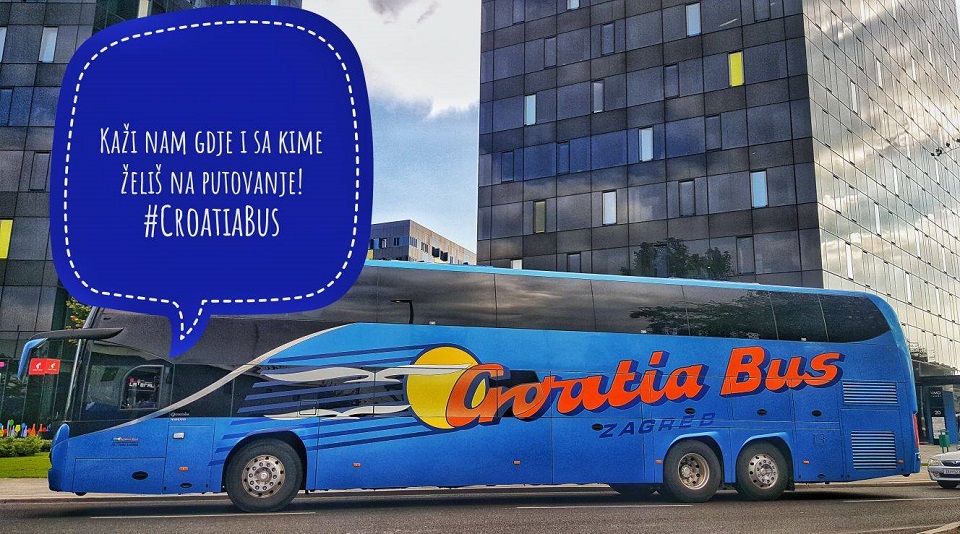
Tell us where and who you want to travel with! | Croatia Bus
Angry Croatia Bus Passenger Gave Location Updates
The angry passenger, one of many who was extremely late to his destination, wrote to the management of Croatia Bus. He left yesterday morning at 4:30am on the bus from Split to Zagreb, and as things stood at 9:40am, they would not arrive until 1pm, according to Slobodna Dalmacija on January 20, 2020.
The Croatia Bus drivers were forced to take a detour due to the bura (or bora, which is an extremely high Adriatic coastal wind), which closed the section of the A1 motorway between Posedarje and Sveti Rok for all vehicles except passenger cars. All others, including buses, were diverted to state roads via Gračac, Obrovac and Karin.
Maslenica Bridge Closed 10 Cumulative Months Since 2008
TCN has written about the frequent closures of this section of the A1 motorway due to high winds, which frequently make crossing the Maslenica Bridge unsafe for most, if not all vehicles. This section of motorway, which includes the Maslenica Bridge, has been closed for 10 cumulative months since 2008 due to unsafe winds.
“As Sveti Rok tunnel was closed, we exited the motorway and the drivers veered onto the Adriatic highway towards Karlobag. We almost reached Sveta Marija Magdalena! There, the drivers turned back after they were informed that the road was closed. We've turned around, and what do you think happened next?” wrote the dumbfounded passenger.
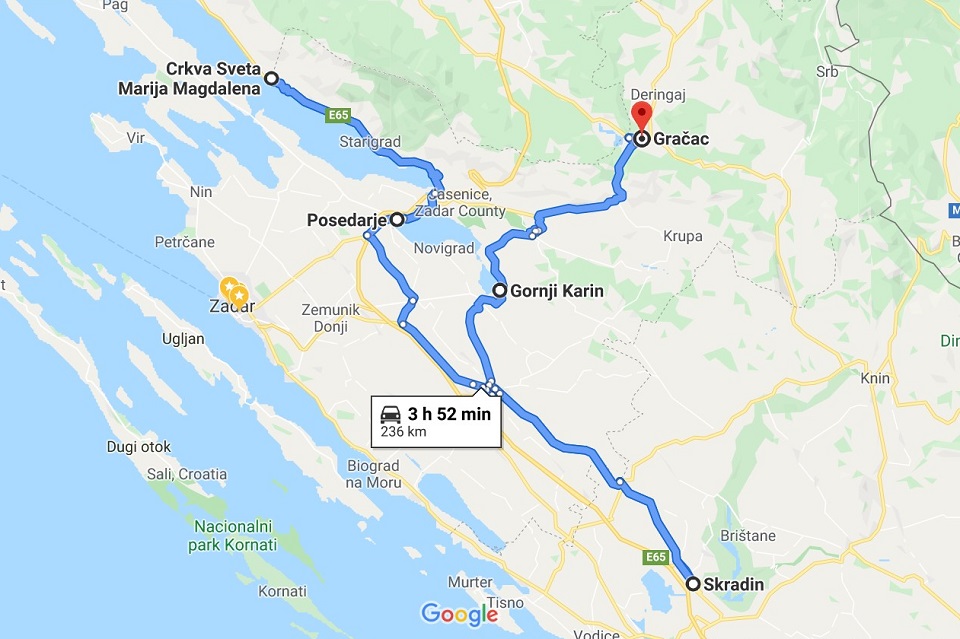
Posedarje - Crvka Sveta Marija Magdelena - Skradin - Karin - Gračac | Four Hour Detour Route
After Heading Toward Karlobag, Croatia Bus Goes to Skradin
“To Skradin, yes, you heard right - Skradin just above Šibenik, and 90 kilometers from Split, our departure station. Now we're finally driving to Zagreb, and we're around Karin. There is a lot more I could write, but I'm afraid we’ll get lost again, I don't know which direction we'll head next time, maybe we’ll end up overseas,” seethed the furious passenger.
His story was confirmed to at the traffic office of Croatia Bus later that morning. At that time, they verified that the bus was somewhere around Gračac, which was 250 kilometers away from Zagreb. The Croatia Bus official acknowledged to that the drivers couldn’t find their bearings after being sent off on a detour before Sveti Rok tunnel, so they went the wrong direction (several times).
Croatia Bus was asked if passengers, many of whom certainly had to be in Zagreb yesterday morning due to urgent obligations, would be compensated. Because who else would take a bus at 4:30 in the morning? An employee of Croatia Bus recommended contacting their legal team.
Follow our Travel page to keep track of lost buses and wind-related road closures.
Hello, 2020: Break Time Kicks Off New Year with Jewelry Franchise
January 21, 2020 - Beginning 2020 in a big way - introducing the Break Time franchise!
A new year calls for new beginnings, and one famous nautical jewelry brand in Croatia is wasting no time with their New Year’s resolution.
After celebrating the fourth anniversary of their first shop, with a collection of shops from Dubrovnik to Istria (Porec and Rovinj), and Zagreb since then, Break Time is turning a new leaf.
“During these four years, we have also constantly received requests for distribution not just from Croatian shops, but also from literally everywhere in the world, from Dubai to Costa Rica. Since all Break Time products were handmade by my partner - our brand artisan, Leonard Copoiu, we very rarely agreed to have a presence in third-party stores.
During this time, we have constantly improved on our products, innovated and added new collections, while - at the same time - learning more and more about managing a growing retail business, what works and what doesn't, how to improve and how to meet and exceed customers' expectations.
We have realized that there is a trending and niche market for original handmade products, such as our quality nautical jewelry and also for monobrand brick-and-mortar stores offering great shopping experiences, just the two of us (me and my partner, Leonard) opening more stores is not going to be sustainable,” Break Time wrote at the beginning of the month.
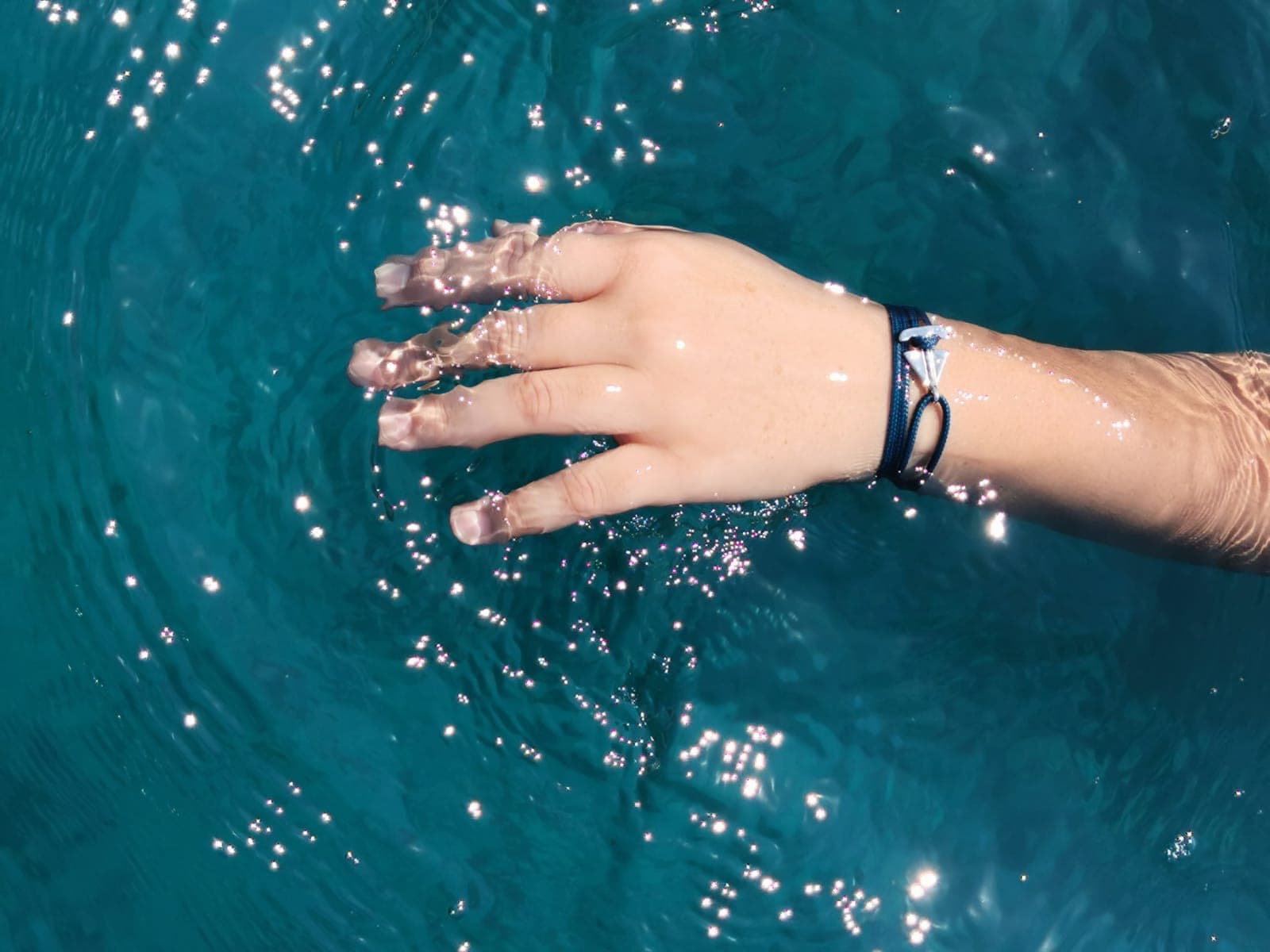
Thus, this week, Break Time nautical jewelry announced that it is ready to share their brand with the world and officially launched a franchise for all fans of sea-inspired artisan jewelry!
“It took us five years to perfect our handcrafted nautical jewelry, to deliver great customer experiences, to gather enough retail-running knowledge, to make enough mistakes and learn from them.
We are now ready to share our brand to the world, so say hello to the Break Time Franchise!” said owners Mirela Rus and Leonard Copoiu upon announcing the big news.
So, if you’re looking for a new business opportunity that:
- Is easy to run, even if you have little experience in retail
- Has proven business results and brings waves of success - fast
- Belongs to an attractive, niche market
- Sells unique products that have taken the market by the storm
...then choose one of the available dates/times, fill in the questionnaire as accurately and in detail as you can, and get a FREE DISCOVERY CALL with the Break Time brand owners, Mirela Rus and Leonard Copoiu, to help you decide if this business is right for you.
With the big franchise news, Break Time has also announced that it will be scaling back on their shops and only maintaining the two Split stores (Trogirska 8 and Zadarska 1), where Mirela and Leonard are based.
“This change will allow us to keep our focus on producing exquisite quality handmade nautical jewelry (of course, Leonard will continue to make part of the products himself and he will also have a team around him to help with the production, while he will still be the one supervising each and every one of the Break Time items being made) and grow our brand through like-minded entrepreneurs such as ourselves, who are looking to invest in a proven business idea and open their own franchise Break Time stores in tourist-oriented coastal towns across the world,” the owners added.
We’d say that 2020 is off to a running start for Break Time!
To make sure you never miss a Break Time beat, follow them on Facebook, Instagram, Twitter, and YouTube, and check out the new Break Time website here.
To read more about lifestyle in Croatia, follow TCN's dedicated page.
City of Split to Charge Cruisers Half the Amount it Could from New Tourist Tax?
January 16, 2020 - A new tourist tax will be paid by cruise ships from January next year, but will Split be making the most of it? A closer look.
Slobodna Dalamacija reports that in just one year, from January 1, 2021, cruisers moored in the port or anchored in the Split area will pay tourist taxes. The Tourist Tax Act, which was passed last year, stipulates that cities and municipalities may, but may not, charge tourist fees for international cruise ships at their ports or anchorages if so decided by the City or Municipal Council.
Fees are charged according to the number of passengers, that is, the capacity of the ship, and the Law stipulates that the minimum fee for ships up to 200 passengers is HRK 2000, while the maximum fee for ships carrying 3000 or more passengers is HRK 40,000. The city or municipality receives 85 percent of that money, and the County 15 percent.
The public consultation, which ended on December 31, 2019, featured a "Draft Proposal for a Decision on the Tourist Fee Amount for Cruise Ships". It proposes that the minimum price be HRK 1,000 and the maximum price HRK 20,000. The City of Split has decided to collect an amount two times less than the law allows.
We must add that the funds collected under the Act are intended to be earmarked for improving public and tourist infrastructure and for projects and programs for sustainable development. In other words, the City of Split gave up half of the money it could have used to improve communal infrastructure, arranging beaches, lighting, bench repairs, horticulture, and so on.
On the other hand, Dubrovnik has decided to charge the maximum amount from 2021. They expect revenues of HRK 10-14 million per year.
Zadar, for example, decided that for the Gaženica port, which is a large infrastructure project made with state money, they would continue to charge nothing to cruisers in order to increase their competitiveness, but also divert cruisers to a location outside the crowded city center. For this reason, cruisers who want to anchor in the city center, next to the ‘Monument to the Sun’ and the ‘Sea Organ’, will be charged the maximum because it is an attractive location.
However, for a spot at the Split city port, right next to the famous Riva and the world-famous Diocletian's Palace, cruise ships are getting a considerable discount.
The initiative to collect fees began in Dubrovnik, which is overrun by cruise ships in the summer.
The power ratio is roughly such that the people of Dubrovnik have more cruisers than Split and Zadar combined. That is, twice as many cruisers come to Dubrovnik annually than to Split, which in turn has twice as many ships as Zadar.
Translated from Slobodna Dalamacija
To read more about travel in Croatia, follow TCN’s dedicated page.
Split Modernizes Public Lighting: 88% of Light Poles to Use LED Bulbs by End of 2020
January 15, 2020 - At a press conference held on Tuesday, Mayor Andro Krstulovic Opara and his associates presented the largest project of energy-efficient public lighting in Croatia - "Modernizing public lighting of the City of Split using the energy service model".
The Mayor stressed the excellent cooperation between the European Bank for Reconstruction and Development (EBRD) consultants and the City of Split project team, who worked together on a solution that resulted in a major reconstruction project and a proposal for modernizing the public lighting system.
"This is a significant project that will not only improve the quality of life in our city, but will also raise standards in an ecological aspect and increase the level of safety of our citizens. Therefore, ecology, energy savings and security are the guiding principles of all activities in this project,” said Opara. City Development and EU Funds Advisor to the Mayor, Kresimir Budisa, explained that the project covers 15,090 lamps or 88 percent of public lighting, with a total investment value of HRK 62 million. He said that the project includes not only the area of Split but also Slatine, Zrnovnica, Stobrec and Sitno Gornje and Donje.
"Annual energy savings and maintenance of public lighting systems are expected to amount to as much as HRK 6.2 million," Budisa said. According to him, the modernization of public lighting in the city of Split includes, among other things, introducing modern and energy-efficient LED lighting throughout the city area, reducing the cost of public lighting and reducing CO2 emissions. It also includes restoring lighting and raising safety in the Marjan tunnel traffic corridor and modernizing lighting on children's playgrounds and sports and recreational areas for citizens.
Budisa also recalled the EU project CitiEnGov, a smart public lighting pilot project implemented in the GK Bacvice, which has proven to be one of the best examples of modernizing public lighting in Central Europe using the latest technologies with exceptional results in reducing electricity consumption, increasing convenience and safety for citizens and visitors, as well as reducing CO2 emissions.
The project presented was prepared with the help of free technical assistance provided by the EBRD, and the proposed financing for the said project is through the Energy Services Model (ESCO). The presentation was also attended by Radojka Tomasevic, Head of the International and EU Projects Department, Hrvoje Jazvic, EBRD representative, and Mate Rebić, EBRD consultant.
To read more about lifestyle in Croatia, follow TCN’s dedicated page.
Croatia Again in Top 10 Countries with Most Booking.com Awards
January 15, 2020 - Booking.com announced the winners of the Traveler Review Awards 2020. Croatia is once again among the top 10 most awarded countries.
HRTurizam reports that nearly one million awards (986,449) were awarded across 220 countries and territories. Among the ten countries with the highest award winners was Croatia, which boasts 42,763 winners.
The awards acknowledge these partners for their superior hospitality and for providing travelers with incredible experiences when booking accommodation.
Numerous countries and destinations continue to provide excellent service year after year, and in 2020, the countries with the most awards include Italy (130,253), Spain (66,755), France (61,492), Germany (49,777), Croatia (42,763), the United States (42,112), the United Kingdom (41,848), Poland (36,793), Russia (36,296) and Greece (33,259).
The spectacular increase in the number of award winners continues this year among apartments. This type of accommodation is again at the top of the list, accounting for almost 40% of winners among accommodation facilities globally in 2020.
For the third year in a row, they made up four of the five most awarded types of accommodation: apartments (380,936), hotels (179,869), private accommodation (94,162), weekend homes (82,241) and bed and breakfasts (75,875). In Croatia, the most awarded accommodation types are apartments (33827), private accommodation (3989), weekend homes (1555), villas (933) and hotels (729).
Although hotels are second in awards globally, three-quarters of all award-winning accommodations (75%) are made up of apartments and holiday homes and other unique accommodations, including options from boats and igloos to country lodging. A recent poll conducted by Booking.com on more than 22,000 travelers found that nearly two-fifths (39%) of global travelers prefer to stay in a weekend home or apartment over a hotel.
Dubrovnik, Zagreb, Opatija, Baska, Cavtat, Osijek, Cres, Korenica, Slunj, and Rakovica provided the warmest welcome on the Croatian market.
On the other hand, the top 10 Croatian accommodations to receive the Traveler Review Awards in 2020 are Apartment Spectre, Zagreb, Embassy Row BnB, Zagreb, Studio Makala, Trogir, Momentum Apartment, Split, Apartments Beso, Makarska, Luxury Apartment Dvor, Split, Apartment Roman Heritage, Split, Neretva Valley Apartments, Metković, Apartmani Nila, Pučišća, and PREMIUM, Osijek.
To read more about travel in Croatia, follow TCN’s dedicated page.
Todoric Family Struggling to Survive: Humanitarian Effort Launched
After Ivica Todoric revealed publicly that his family is struggling to survive, a Split association will organize a humanitarian effort this Sunday. Citizens can bring food, clothing and other supplies. The president of the association promised that he would deliver everything in person to Kulmorovi dvori on Monday January 20, 2020.
As reported by Lauren Simmonds/TCN, on January 9, 2020; Ivica Todoric, who is awaiting trial in Croatia, has alerted the media that he and his family are struggling to survive. His announcement has provoked quite a response because he was known to have been one of the richest people in Croatia for decades.
His words have been taken seriously by Jakša Bulić, president of the association for national development “Bili cvitak”.
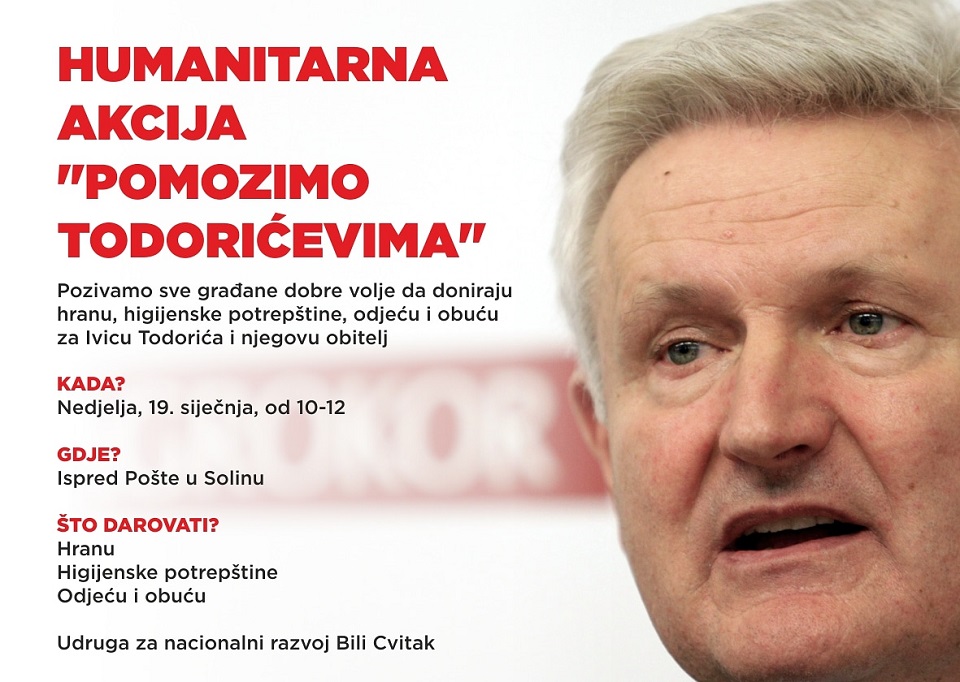
Bili Cvitak Launches Humanitarian Effort to Help Todorics
Therefore, he has announced a humanitarian effort "Let's Help the Todorics", which will be held on Sunday, January 19, 2020 in Solin. The association calls on all citizens of goodwill to donate food, hygienic supplies, clothing and footwear to Ivica Todorić and his family, according to Dalmacija danas on January 13, 2020.
“We have decided to launch "Let's Help the Todorics" a humanitarian effort for religious citizens and Catholics collect donations and supplies for the Todorics. On Sunday, January 19, 2020 we will collect everything from 10am to 12pm in front of the post office in Solin,” announced Jakša Bulić, president of the association.
Donations Will be Delivered to Todoric Residence on Monday
They group has already participated in various humanitarian efforts, such as an effort to build a school and a water supply system in Ogorje.
Citizens can bring food, shoes, clothing and other supplies, and the president of the association confirmed to Dalmacija danas that he will bring everything in person to Kulmorovi dvori, the Todoric residence, on Monday.
“It is up to Mr. Todoric whether he will accept our donations, but it is important for us as citizens to show our goodwill,” Bulić emphasized.
Follow our Lifestyle page to keep updated on the upcoming trial of Ivica Todoric.
Jadrolinija Renews Fleet with 'Faros' Ferry to Sail Between Split and Stari Grad
January 14, 2020 - After a three-day voyage from Greece, and under the command of Captain Sandro Rundic, the 'Faros' ferry arrived in Croatia on Monday. The newest ferry in Jadrolinija's fleet should primarily connect Split and Stari Grad on Hvar before Easter this year.
Slobodna Dalmacija reports that the ‘Faros’ boasts a capacity of 600 passengers and 160 vehicles, was built ten years ago in Greece under the name "Stelios Filiagkos", and the state-owned shipping company purchased it from Agios Nikolaos (Saint Nicholas) from Salamina for just over HRK 63 million or EUR 8.5 million.
The Faros thus became the 52nd member of Jadrolinia's fleet. It is 104.9 meters long and 17.5 meters wide, and two Caterpillar machines with a total of 2000 horsepower provide a speed of 14 knots. The ferry is named after the ancient name of Stari Grad, the first Greek colony on the Adriatic.
The deal on the ferry, which was offered to the market five years ago, was concluded this fall, but the handover to the Croatian crew was made only ten days ago at the port of Kavala on the eastern Aegean coast, some 100 kilometers from Thessaloniki. The ship was then inspected by inspectors of the Croatian Register of Ships, who found no deficiencies and issued provisional certificates for navigation to the Adriatic.
Until recently, Stelios Filiagkos sailed from Kavala on a regular line to the island of Thassos, about 13 nautical miles away. The distance is twice as long to the main ferry port on the island of Hvar, which will be a real test for yet another Jadrolinia acquisition from Greece.
“I am extremely proud that we are connecting the Jadrolinija fleet with a ship which, by its capacity and speed, will significantly contribute to improving the quality of passenger transport service, especially in the summer months. The ferry will be at the Kraljevica Shipyard for the necessary equipment and preparation for the season, and we expect it to run from the spring. We believe that this offering in the fleet will satisfy the growing demands for passenger and vehicle transportation services in the Split area,” said David Sopta, President of Jadrolinija's Management Board.
"This is another step in modernizing our fleet, all to successfully fulfill the concession contract obligations with the state. In addition, this investment also achieves optimization of technical maintenance costs and long-term business stability. The ferry ‘Faros’ is primarily intended for navigation on the line Split - Stari Grad, but if necessary, it can be used for other lines concessioned by our company. With its large garage and passenger lounge capacity, it will make a significant contribution to improving the quality of service, especially during the summer months,” said the management of the Croatian company.
At the end of November, contracts were signed between Jadrolinia and a Russian company to buy two second-hand ferries, worth almost HRK 38.5 million, which also have Greek roots. However, since negotiations are still underway on conditions, handovers are expected in late January or early February.
These ships have long sailed on lines across the Kerch Strait, at the "junction" of the Black and Azov Seas. Still, since Russia has linked its territory with the occupied Ukrainian peninsula of Crimea by bridge, maritime connections are slowly losing their significance.
To read more about travel in Croatia, follow TCN’s dedicated page.
Croatian Property Price Data Highlights Dramatic North-South Divide
The north-south divide is a common situation in many European countries. The United Kingdom is one notable example, in which the south absorbs an enormous amount of money as the north tends to get mere scraps. This is more or less down to the fact that London is situated in the south of the country, but what then, with its capital in the north, is Croatia's excuse? Tourism and the sea are safe bets... A look at Croatian property prices reveals some shocking statistics.
As Novac writes on the 11th of January, 2020, the dramatic difference between the north and the south of Croatia is reflected in the prices of family homes, according to the latest analysis of the Ministry of Construction and the Institute of Economics in Zagreb - "Croatian Real Estate Market Review 2018", which delves deep into the Croatian property market and the huge differences between north and south.
These are real transaction prices, so this analysis most certainly shows the real state of the estate market and Croatian property prices. In the continental town of Bjelovar, the lowest median price per square metre in a house was a mere 36 kuna. After that come Koprivnica (54 kuna), Virovitica (62 kuna) and homes in Požega-Slavonia County (86 kuna).
The most expensive square metre in a house at the median price was in Split-Dalmatia County (4,354 kuna), Primorje-Gorski kotar County (4,334 kuna) and Šibenik-Knin County (4,228 kuna). According to the analysis, it would mean that for the price of one 100-square-metre house in Split, one hundred houses of the same size can be bought in, for example, Bjelovar. An enormous, hardly comprehensible difference within one small country.
Could this really be so? This incredible difference in Croatian property prices seems truly remarkable, so Novac asked one of the authors of the analysis, Maruška Vizek, a scientist from the Institute of Economics. She explained that the data does indicate massive regional differences in Croatian property prices, but they can be even further magnified if the data from eNekretnine, the system from which they collected the sales contracts, isn't evaluated.
''In other words, it's possible that intentionally lower prices than market prices are put into purchase contracts to reduce the amount of property sales tax, and then we see even greater price differences between regions,'' she explained.
Concerning apartments, the same analysis states that back in 2018, 23,736 apartments and flats with a total value of 13.2 billion kuna were sold. Taking first place with a median price of an apartment/flat of 12,158 kuna per square metre is, rather unsurprisingly, Dubrovnik-Neretva County, followed by Split-Dalmatia County with the price of 11,669 kuna and then the City of Zagreb with the price of 9,459 kuna.
Median apartment/flat prices in other counties ranged from 2,967 kuna per square metre in Vukovar-Srijem County to 5,840 kuna in Osijek-Baranja County. This would mean that for one square metre in an apartment/flat in Dubrovnik-Neretva County, you could purchase 4.1 square metres in Vukovar-Srijem County, since the difference in the median price per square metre between the two counties is as high as 9.191 kuna.
Make sure to follow our dedicated lifestyle page for more on Croatian property prices.
A Look at New Luxury Hotels Opening in Croatia in 2020
January 10, 2020 - A number of new hotels will open in Croatia this year. A look at five unique luxury hotels that should open this spring or at the start of the tourist season.
According to the eVisitor system, more than 1,170 hotels with about 172,000 beds are registered in Croatia.
Of the total accommodation capacity, which amounts to about one million beds, hotels account for only about 12 percent.
However, five hotels will improve that ratio somewhat. A look at the new luxury hotels opening in Croatia this year, courtesy of T.portal.
Hotel Costabella, Rijeka
The five-star Costabella Hotel Complex is set to open this summer. It will have 280 rooms with a total of 560 beds, a large area for wellness, fitness and a private sandy beach.
All rooms and suites will have views of the Kvarner Bay. The resort will offer six restaurants, a beach bar, and a rooftop restaurant.
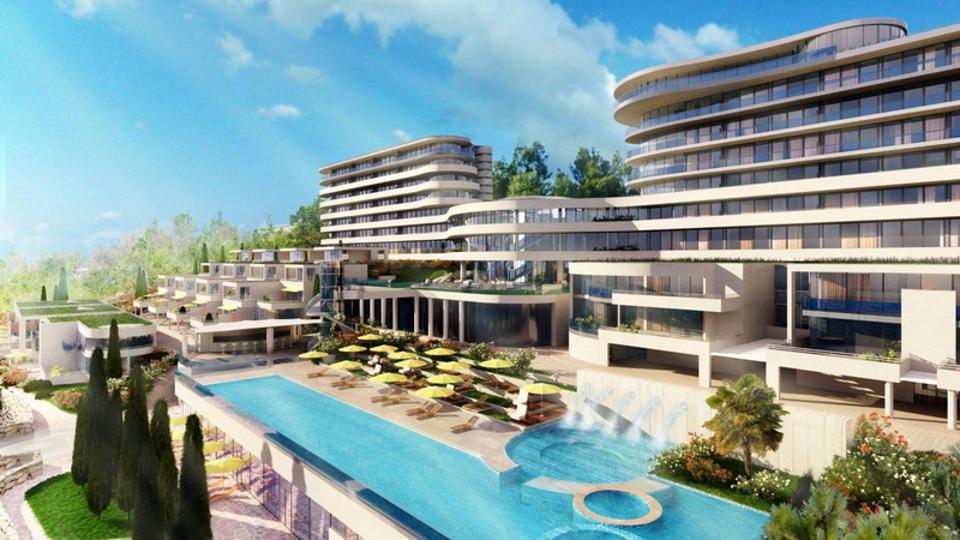
Costabella Simulation / Facebook
The investment is worth as much as 80 million euros. The investor is JTH Costabella. The resort will be part of the Hilton hotel chain.
Hotel Ambasador, Split
The new Ambassador Hotel is expected to have four-plus stars, with 101 rooms and suites, 240 restaurant seats, a spa, a gym, a nightclub and an underground garage with 59 spaces.
The Ambassador is seeing an investment by one of the world's most famous shoemakers, Klaus Alex Birkenstock, who announced that he was planning to build a new favorite tourist resort for tourists from the United Kingdom, Germany, Austria and France from the once dilapidated building on the Split waterfront.
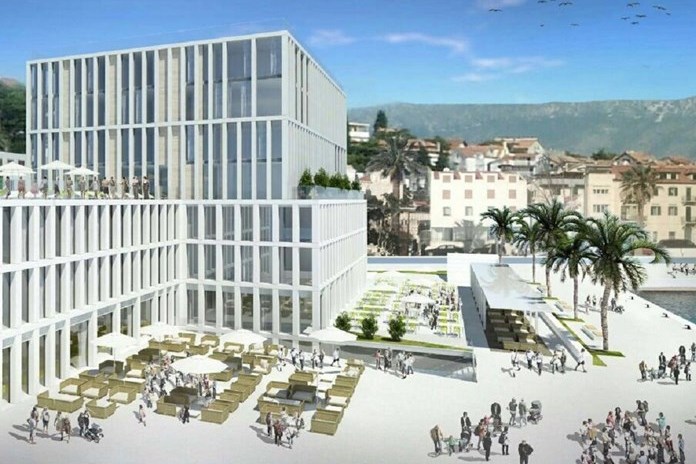
Ambasador Simulation
Birkenstock has invested around 17 million euros in the new hotel.
Hotel Armerun, Šibenik
The Armerun Hotel will have 17 accommodation units, 14 of which are in the property itself, while three are in a separate property that can be rented as a villa. It will have two categorizations, one with four stars and as a heritage hotel.
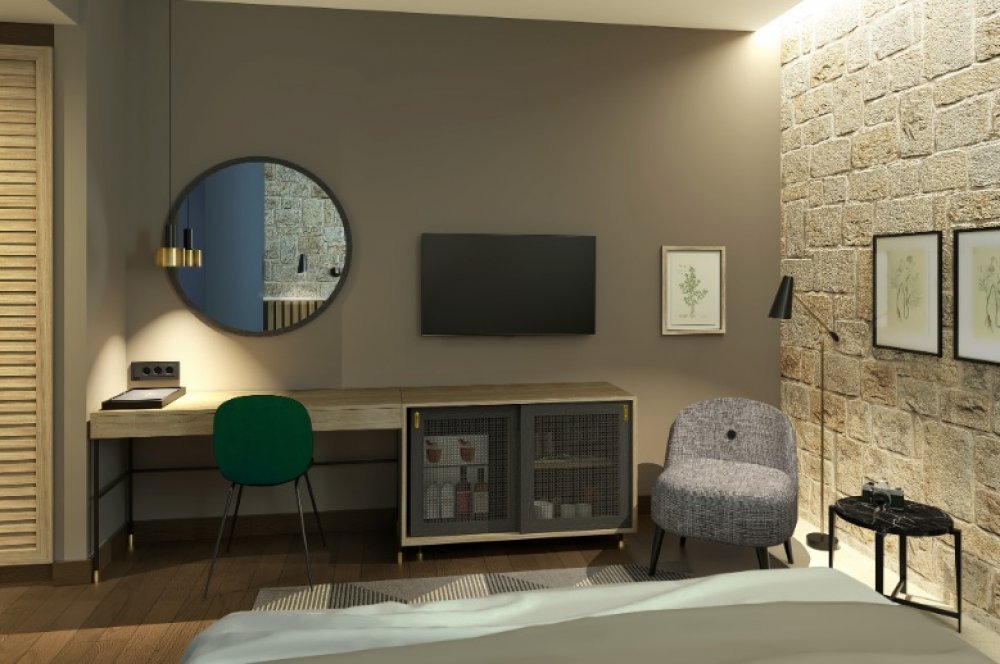
Screenshot
On the ground floor of the hotel, there will be a restaurant for outside guests to enjoy.
The hotel is scheduled to open in the spring of 2020. The total value of the investment is around 2 million euros and the main investor is the company Stanovi Jadrana.
Amfora Resort, Split
The Hotel Amfora by Zvonko Kotarac, a businessman from Split, was supposed to open last year, but due to construction problems (and an invalid building permit), the opening has been delayed.
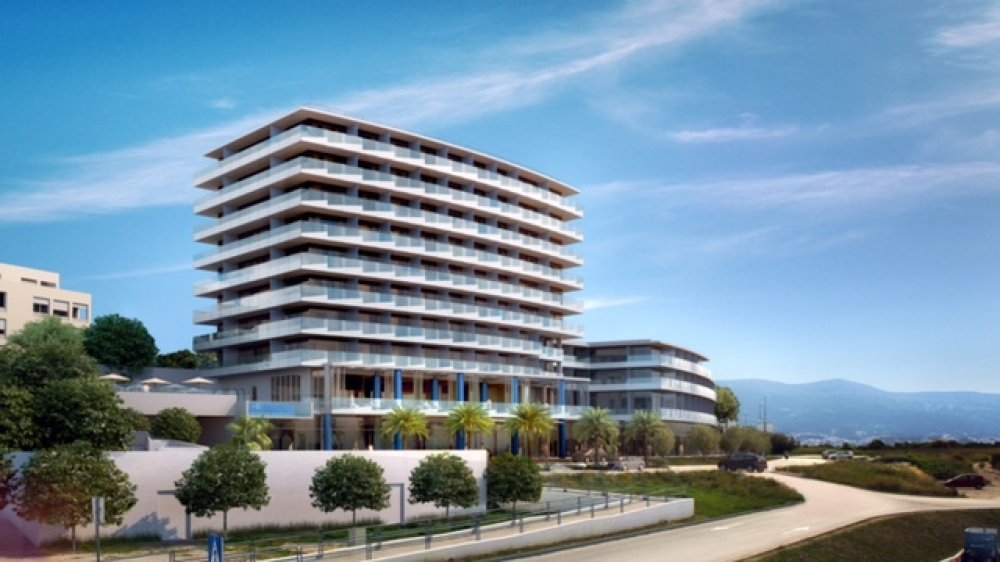
Amfora Simulation
The total investment is over 26 million euros. The investor insisted that the hotel would have 207 rooms and suites, a 500-seat congress hall and 2000 square meters of wellness.
Courtyard by Marriott, Split
Courtyard by Marriott, the business brand of the renowned Marriott International Group, should also open this year. The hotel is located in the Dalmatia Tower, the tallest building in Croatia, standing 115 meters tall.
Courtyard by Marriott will be located on the building’s top floors, from the 16th to 26th, allowing guests a spectacular view of the city, and because of the specific shape of the building, each of the 190 rooms and four suites will have sea views.
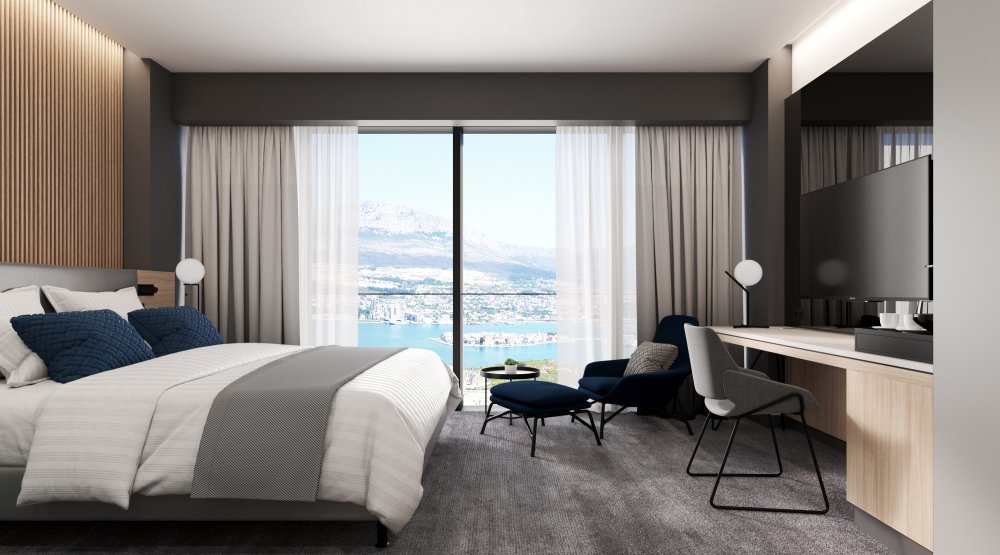
Westgate Group
In addition to the conference facilities, the hotel will feature a wellness area, a gym, a restaurant and a bar.
To read more about travel in Croatia, follow TCN’s dedicated page.


